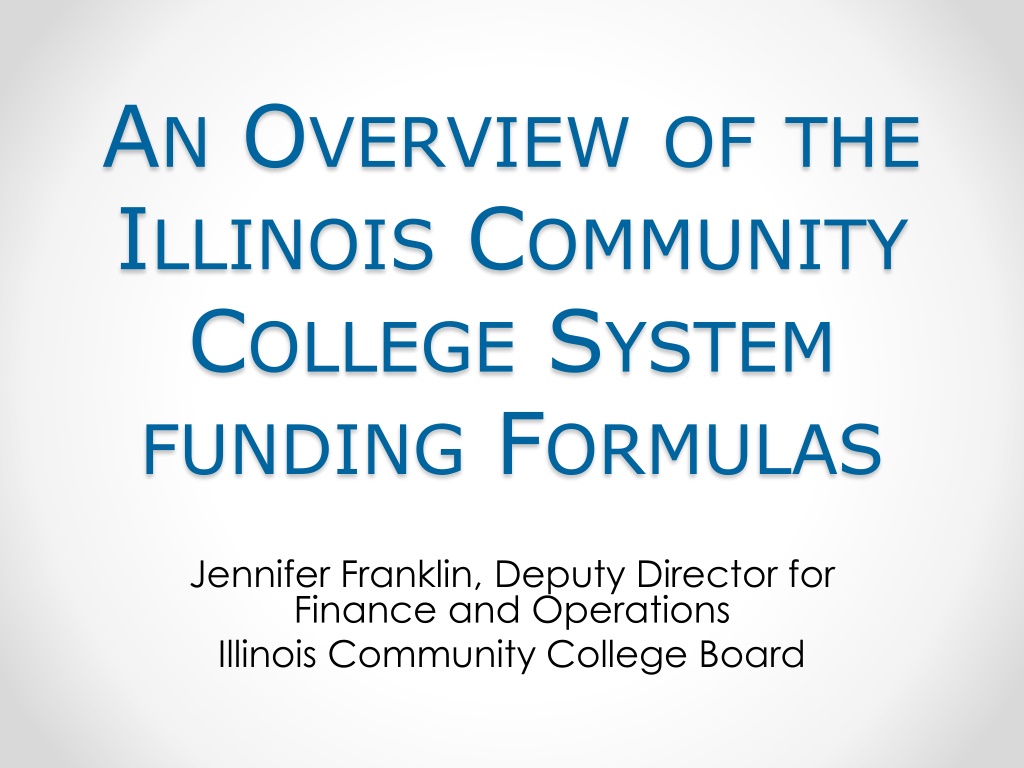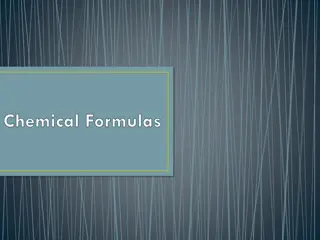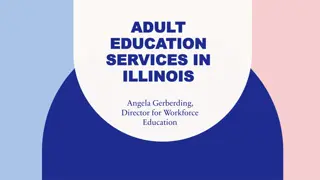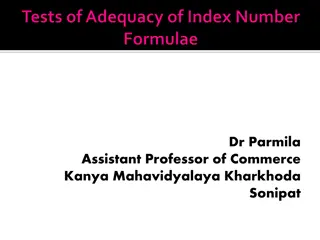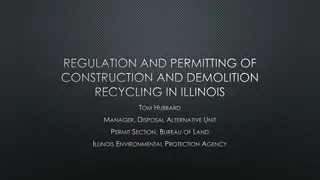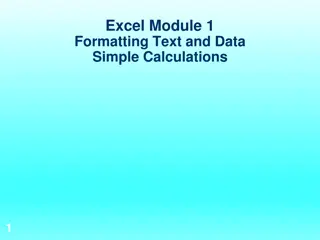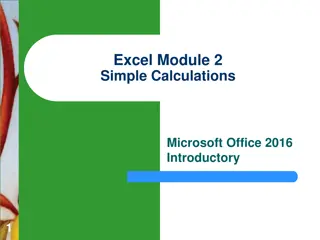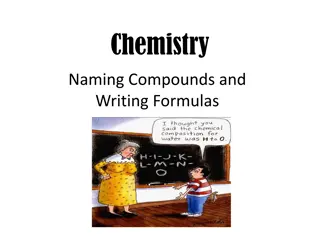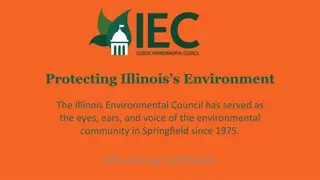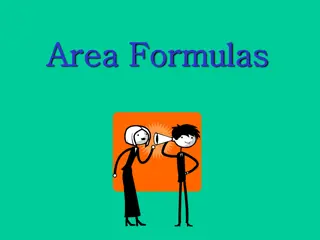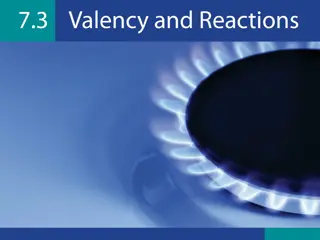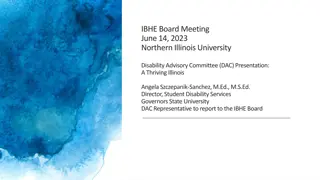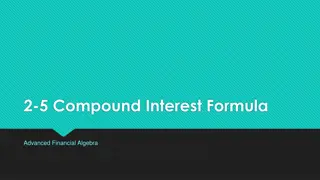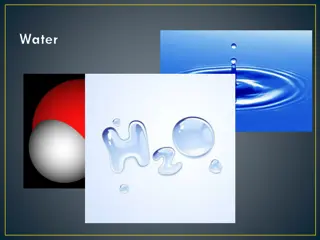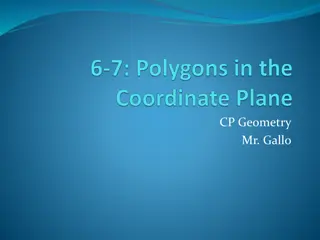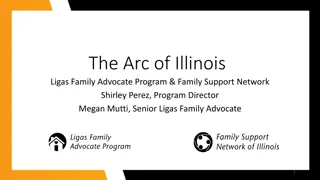Understanding the Funding Formulas of the Illinois Community College System
Explore the detailed overview of the funding formulas utilized by the Illinois Community College System, including information on unrestricted and restricted grants, base operating grants, credit hour grant rates, and other essential financial aspects. Gain insights into how funds are distributed and allocated to support various educational initiatives within the community college system.
Download Presentation

Please find below an Image/Link to download the presentation.
The content on the website is provided AS IS for your information and personal use only. It may not be sold, licensed, or shared on other websites without obtaining consent from the author. Download presentation by click this link. If you encounter any issues during the download, it is possible that the publisher has removed the file from their server.
E N D
Presentation Transcript
AN OVERVIEW OF THE ILLINOIS COMMUNITY COLLEGE SYSTEM FUNDING FORMULAS Jennifer Franklin, Deputy Director for Finance and Operations Illinois Community College Board
SYSTEM GRANTS UNRESTRICTED GRANTS Base Operating Equalization Performance- Based Funding Illinois Veterans/ National Guard Small College Grants
SYSTEM GRANTS RESTRICTED GRANTS Distributed to the system for special activities. Adult Education & Literacy Career & Technical Education Special Initiatives *CURES/CARES/CRSSA/ARPA *Innovative Bridge & Transition *Workforce Equity Initiative *Early Childhood Education *PATH
BASE OPERATING GRANTS Base operating grants are unrestricted funds disbursed to community colleges based on credit hours generated in six reimbursable instructional categories. Base Operating Grants formula = Funded Credit Hours x Effective Credit Hour Rate
BASE OPERATING GRANTS Funded credit hours - Greater of most recent FY certified unrestricted credit hours, or 3-year average. Credit hour rate - Instructional cost per credit hour, adjusted for inflation*; Less district tuition & fees, and local tax revenue. Effective credit hour rate Proration factor applied to the net reimbursable credit hour rate as necessary to equal State appropriations. *Inflationary adjustments are necessary due to the two-year lag in data.
BASE OPERATING GRANTS CREDIT HOUR GRANT RATES BY CATEGORY FOR FISCAL YEAR 2023 Totals/ Averages Baccalaureate Business Technical Health Remedial ABE/ASE FY2021 Unit Cost $ 422.57 $ 456.97 $ 430.15 $ 572.29 $ 300.81 $ 443.01 $ 431.56 FY2022 Weighted Cost $ 505.36 $ 546.50 $ 514.43 $ 684.41 $ 359.75 $ 529.81 $ 516.11 Less: Tuition & Fees Local Tax Revenue Total $ 149.03 $ 149.03 $ 149.03 $ 149.03 $ 149.03 $ - $ 193.16 $ 193.16 $ 193.16 $ 193.16 $ 193.16 $ 193.16 $ 193.16 $ 342.19 $ 342.19 $ 342.19 $ 342.19 $ 342.19 $ 193.16 $ 317.35 $ 124.19 Credit Hour Rate $ 163.17 $ 204.31 $ 172.24 $ 342.22 $ 17.56 $ 336.65 $ 198.76 State Adjustment* $ (125.69) $ (157.38) $ (132.68) $ (263.61) $ (13.53) $ (259.32) $ (153.11) Effective Credit Hour Rate $ 37.48 $ 46.93 $ 39.57 $ 78.61 $ 4.03 $ 77.33 $ 45.66 *Proration factor applied to meet State appropriation.
BASE OPERATING GRANTS Baccalaureate Business Technical Health Remedial ABE/ASE Total Funded Hours 2,963,885 276,920 469,916 364,809 256,342 213,910 4,545,782 Effective Rate 37.48 46.93 39.57 78.61 4.03 77.33 Total 111,093,820 12,996,187 18,592,559 28,678,516 1,033,965 16,542,152 188,937,200
BASE OPERATING GRANTS Impacts to annual grant allocations: Instructional Cost Funded Hours Tuition & Fees Local Tax Revenue State Appropriations
BASE OPERATING GRANTS ANNUAL DEFICIT IN FUNDING $1,000,000,000 $800,000,000 $600,000,000 $400,000,000 $200,000,000 $- FY 2010 FY 2015 FY 2016 FY 2017 FY 2018 FY 2019 FY 2020 FY 2021 FY2022 FY2023 $(200,000,000) $(400,000,000) $(600,000,000) $(800,000,000) Reimbursable Credit Hours Earned Credit Hour Appropriation Annual Deficit
BASE OPERATING GRANT UNRESTRICTED CREDIT HOURS
EQUALIZATION GRANTS Grants were established by statute to reduce disparity of local property tax funds available per student between districts. A base foundation level of expected tax revenue per student is calculated from EAV and PPRT. Districts with EAV PPRT rate below the calculated foundation level are eligible for funding. Proration factor applied if State appropriations do not meet the fully funded threshold level. A minimum $50,000 grant is awarded to districts that qualify for Equalization but become ineligible due to the proration factor.
EQUALIZATION GRANTS Calculation of Grant Allocation District s tax revenue per FTE < Base Foundation Level = Eligible full funding; proration factor applied to Base Foundation Level if necessary. Minimum $50,000 grant for districts who qualify for full funding, but not under prorated funding.
EQUALIZATION GRANTS FY2023 Formula Lesser of 2021 CPPRT or two-year average: Statewide Weighted Average Tax Rate: CPPRT inflated by Statewide Avg. Tax Rate: $59,777,477 0.0024545 24,354,237,930 $ divide equals Adjusted CPPRT: < of 2020 EAV or 2yr Avg. Total 24,354,237,930 371,429,938,210 395,784,176,140 $ plus equals In-District FTE: Local Rev. per In-District FTE: divide 144,431 2,740,299 $ Statewide Weighted Average Tax Rate: Statewide Threshold: times equals 0.0024545 6,726 $
EQUALIZATION GRANTS Statewide Threshold: equals $ 6,726 Underfunding Prorated Factor Prorated Threshold: times equals 0.786634458 5,292 $ Statewide threshold is prorated to equal State appropriations. Districts with a EAV CPPRT rate below the Statewide threshold and Prorated threshold qualify for Prorated funding. Formula = (District EAV CPPRT rate - Prorated Threshold) x FTE. Districts qualifying for full funding, but ineligible under prorated funding, will receive a minimum $50,000 grant.
EQUALIZATION GRANTS ANNUAL DEFICIT IN FUNDING
EQUALIZATION GRANTS Impacts to annual grant allocations: EAV FTE State PPRT Appropriations
OTHER UNRESTRICTED GRANTS Performance-Based Funding: Beginning in fiscal year 2013, the Illinois public higher education budget is statutorily required to include a performance-based component in the annual funding allocations. Community college performance funding measures were developed by a group of representatives from the system. As outlined in Public Act 97-320, the measures award community college performance for advancing success of students who are academically or financially at risk and focus on increasing college course, certificate, and degree completion.
OTHER UNRESTRICTED GRANTS Measures for Performance-Based Funding: 1. Degree & Certificate Completion 2. Degree & Certificate Completion of At-Risk Students 3. Transfer to a 4-year Institution 4. Developmental Advancement 5. Momentum Points 6. Transfer to a Community College
OTHER UNRESTRICTED GRANTS Small College Grants: A flat grant of $50,000 is distributed to districts with 2,500 or less full-time equivalent(FTE). Districts below 2,000 FTE, below $850 million equalized assessed valuation(EAV), and qualify for an equalization grant, receive an additional $50,000 grant. These districts have fewer discretionary dollars and a greater percentage allocated to fixed costs than do larger districts. of their budget
OTHER UNRESTRICTED GRANTS Veterans Grants Prior to FY20, annual appropriations were line item by institution. The appropriation language did not allow claims for tuition waivers for Illinois National Guard veterans. In FY20, Public Act 100-0007 was amended to include reimbursement associated with Illinois National Guard veterans in addition to Veterans grants. In FY22, Public Act 102-0017 appropriated the full amount to ICCB to be allocated equitably among the colleges. for tuition waivers
RESTRICTED GRANTS Adult Education Grants MOE Allocations based on formula Grant Agreements Restricted Accounts Career and Technical Education MOE Allocations based on formula Grant Agreements Restricted Accounts
RESTRICTED GRANTS Special Initiatives Federal or State funded Grant Agreements Allocations may be formula-based Restricted Accounts
Questions? Jennifer Franklin, Deputy Director Finance & Administration Illinois Community College Board 217.785.0031 Jennifer.L.franklin2@Illinois.gov
